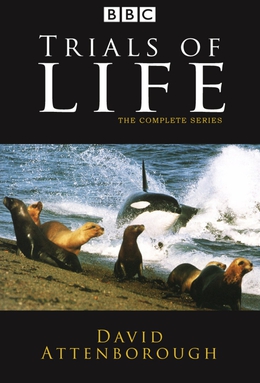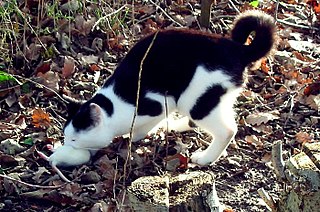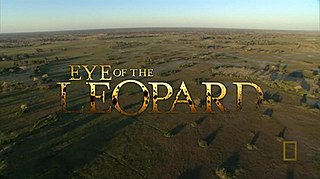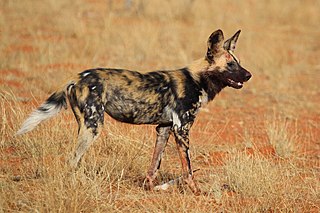Related Research Articles

Predation is a biological interaction where one organism, the predator, kills and eats another organism, its prey. It is one of a family of common feeding behaviours that includes parasitism and micropredation and parasitoidism. It is distinct from scavenging on dead prey, though many predators also scavenge; it overlaps with herbivory, as seed predators and destructive frugivores are predators.

Nocturnality is an animal behavior characterized by being active during the night and sleeping during the day. The common adjective is "nocturnal", versus diurnal meaning the opposite.

The Trials of Life: A Natural History of Behaviour is a BBC nature documentary series written and presented by David Attenborough, first transmitted in the United Kingdom from 3 October 1990.

The striped hyena is a species of hyena native to North and East Africa, the Middle East, the Caucasus, Central Asia and the Indian subcontinent. It is listed by the IUCN as near-threatened, as the global population is estimated to be under 10,000 mature individuals which continues to experience deliberate and incidental persecution along with a decrease in its prey base such that it may come close to meeting a continuing decline of 10% over the next three generations. It is also the national animal of Lebanon.

The brown hyena, also called strandwolf, is a species of hyena found in Namibia, Botswana, western and southern Zimbabwe, southern Mozambique and South Africa. It is currently the rarest species of hyena. The largest remaining brown hyena population is located in the southern Kalahari Desert and coastal areas in Southwest Africa. The global population of brown hyena is estimated by IUCN at a number between 4,000 and 10,000 and its conservation status is marked as near threatened in the IUCN Red List.

The spotted hyena, also known as the laughing hyena, is a hyena species, currently classed as the sole extant member of the genus Crocuta, native to Sub-Saharan Africa. It is listed as being of least concern by the IUCN on account of its widespread range and large numbers estimated between 27,000 and 47,000 individuals. The species is, however, experiencing declines outside of protected areas due to habitat loss and poaching. The species may have originated in Asia, and once ranged throughout Europe for at least one million years until the end of the Late Pleistocene. The spotted hyena is the largest known member of the Hyaenidae, and is further physically distinguished from other species by its vaguely bear-like build, its rounded ears, its less prominent mane, its spotted pelt, its more dual purposed dentition, its fewer nipples and the presence of a pseudo-penis in the female. It is the only mammalian species to lack an external vaginal opening.

The Beast of Gévaudan is the historical name associated with a man-eating animal or animals which terrorised the former province of Gévaudan, in the Margeride Mountains of south-central France between 1764 and 1767. The attacks, which covered an area spanning 90 by 80 kilometres, were said to have been committed by one or more beasts with formidable teeth and immense tails, according to contemporary eyewitnesses. Most descriptions from the period identify the beast as a wolf, dog, or wolf-dog hybrid.

A pack hunter or social predator is a predatory animal which hunts its prey by working together with other members of its species. Normally animals hunting in this way are closely related, and with the exceptions of chimpanzees where only males normally hunt, all individuals in a family group contribute to hunting. When hunting cooperation is across two or more species, the broader term cooperative hunting is commonly used.

Defined narrowly, a game stalker is a hunter who for sport, approaches close to its timid quarry before making a kill. The practice is commonly associated with the moors of Scotland where the principal quarry is red deer. However, the skill is found worldwide and is of extremely long standing. Many other species such as cats and hyenas also stalk their prey.

Thylacoleo carnifex, a marsupial lion, is an extinct species of carnivorous marsupial mammal that lived in Australia from the early to the late Pleistocene. Despite its name, it is not closely related to the lion, but is a member of the order Diprotodontia, one of the taxonomic groups of Australian marsupials.

Eye of the Leopard is a 2006 National Geographic documentary directed by Derek and Beverly Joubert. Set in the Mombo region of the Okavango Delta, Botswana, the film explores the life of a female leopard, Legedema, as she matures from a cub to an adult. Jeremy Irons, voice actor of Scar from Disney’s 1994 animation The Lion King, narrates the film. It premiered in the US on the National Geographic Channel on October 8, 2006, and has won many awards including the BBC wildscreen Panda award for Best Sound Wild Screen and an Emmy. Since the success of the film, a book and an app of the same title have been released.

Supersense is a six-part nature documentary television series produced by the BBC Natural History Unit, originally broadcast in the United Kingdom on BBC1 in 1988. The series producer was John Downer and the narrator Andrew Sachs. It used groundbreaking effects and filming techniques to show how animals perceive the world around them. The same production team went on to make the follow-up series Lifesense in 1991 and Supernatural: Unseen Power of Animals in 1999.

The giant cheetah is an extinct felid species that was closely related to the modern cheetah.
Man-eater is a colloquial term for an individual animal that preys on humans as a pattern of hunting behavior. This does not include the scavenging of corpses, a single attack born of opportunity or desperate hunger, or the incidental eating of a human that the animal has killed in self-defense. However, all three cases may habituate an animal to eating human flesh or to attacking humans, and may foster the development of man-eating behavior.

The African wild dog, also called the painted wolf or Cape hunting dog, is a canine native to sub-Saharan Africa. It is the largest indigenous canine in Africa, and the only extant member of the genus Lycaon, which is distinguished from Canis by dentition highly specialised for a hypercarnivorous diet, and a lack of dewclaws. It is estimated that about 6,600 adults including 1,400 mature individuals live in 39 subpopulations that are all threatened by habitat fragmentation, human persecution and outbreaks of diseases. As the largest subpopulation probably consists of less than 250 individuals, the African wild dog is listed as endangered on the IUCN Red List since 1990.
Built for the Kill is a nature series made by Granada Wild for the National Geographic Channel. It was produced from 2001–2004, with a total of 31 episodes. Each episode runs for approximately 48 minutes including the credits and opening titles.

Pursuit predation is a form of predation in which predators give chase to fleeing prey. The chase can be initiated either by the predator or by the prey, should the prey be alerted to a predator's presence and attempt to flee before the predator gives chase. The chase ends when either the predator captures and consumes the prey, or the prey escapes. Pursuit predation is typically observed in carnivorous species within the kingdom Animalia, with some iconic examples being cheetahs, lions, and wolves.
References
- ↑ "Killing for a Living". MSN. Archived from the original on April 18, 2011. Retrieved January 28, 2010.